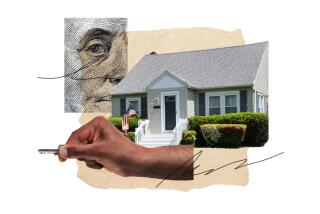Living Separately and Unequally
- Share via
This month marks the 40th anniversary of the Civil Rights Act of 1964, our nation’s most comprehensive civil rights law. In 1964, about 87% of the population was white, 10% was black and the small remainder was composed of other races. Today, Latinos outnumber African Americans, and it is predicted that by mid-century minorities will be the majority in the United States. In offering the promise of equal opportunity, the law laid the groundwork for a thriving, multiracial America.
Among its many provisions, the law barred racial discrimination in public accommodations, employment and virtually all federally funded activities, including education, and prohibited certain discriminatory activities based on other characteristics such as religion, national origin and gender. According to the Census Bureau, since 1964 the percentage of blacks age 25 and older who obtain at least a high school diploma has risen from 26% to 79%. The black poverty rate has declined from about 42% to 24%.
And yet serious gaps of racial inequality persist. Why? At least in part because housing segregation persists. It was not until 1968, in the wake of Martin Luther King Jr.’s assassination, that Congress passed the Fair Housing Act -- a tepid law with limited penalties and weak enforcement mechanisms. It was only in 1988, when the act was amended, that the United States finally adopted a housing anti-discrimination law with teeth. Still, our neighborhoods remain highly segregated along lines of race and class.
Among racial minorities, African Americans are the most segregated. Demographers, interpreting the 2000 census, say 65% of all black people would have to move in order to be evenly distributed among whites. Only the black poor experience “hyper-segregation” -- extreme ghetto isolation, a parallel universe of violence and social distress. Where blacks or Latinos exist in large numbers, whites have fled. As a result, more than half of our largest cities became majority-minority in the 1990s; Anaheim, for example, saw its white population decline from 57% to 35%.
When it comes to where the races and classes live, we are ignoring some difficult questions. Where you live heavily influences what schools you will go to, what employers you will have access to and whether you will be exposed to a host of models for success.
Public schools have been re-segregating rapidly for more than a decade in large part because the Supreme Court has allowed a return to neighborhood schools, holding that districts are not required to overcome segregated housing. In Charlotte-Mecklenburg, N.C., for example, the percentage of black students attending mostly black schools rose from 19% in 1991 to 48% in 2002.
Nationally, black and Latino public school students, on average, attend majority-minority, heavily poor schools, where a poverty culture that denigrates learning can prevail, while white public school students tend to be in majority-white, majority middle-class schools with greater advantages. The U.S. General Accounting Office found that wealthy districts on average had 24% more funding per pupil than poor districts, where black and Latino students are overrepresented.
How can American society be called democratic when the ability to live in a safe, decent area with high-quality public schools is limited largely to those who can afford exclusive enclaves? Although we have eliminated Jim Crow laws, public and private institutional policies tend to steer us apart. From local zoning codes that prevent mixed- income or affordable housing, to private databases that skew public funding and private development toward affluent, heavily white neighborhoods, to pervasive steering of black and Latino home buyers and renters to “appropriate” areas, our policy choices result in communities of great abundance and great need.
There is an alternative. In those few islands of stable integration -- such as southeast Seattle or Fruitvale in Oakland -- and in communities that have taken on the hard issue of race and class inclusion -- such as the Twin Cities area of Minnesota -- citizens are forming coalitions among formerly strange bedfellows and demanding more enlightened public policies.
The civil rights movement was premised on a vision of inclusion. Though we accept that beautiful vision in the abstract, we have not yet achieved full and equal opportunity for all. We still have work to do.
*
Sheryll D. Cashin, author of “The Failures of Integration, How Race and Class Are Undermining the American Dream” (PublicAffairs 2004), is a professor of law at Georgetown University.


